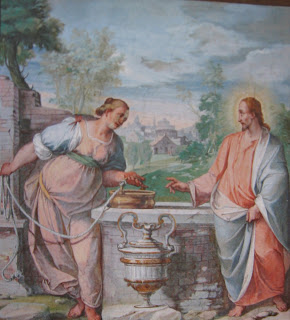Student and professor
Michael Angel was a
professor of art history and he usually wanted that pupils were true author of
lessons, in fact he hates very deeply those academic posture and roles to professor,
he asked to pupils always why? Students were very involved in this method, and
they want comment always every artistic work, but Michael Angel asked always
that this was with intelligence and not certainly with description, very
useless, therefore he would treated in that year Caravaggio; therefore students
who have visited Rome and other Italian cities where they could see Caravaggio,
but also Malta where is other work of Caravaggio; Michael Angel has given
bibliography about Caravaggio, and he has advised students read these book and,
above all, see works, because he said always: “Books and documents are tools
for understand the works and no certainly aim of our search; when you have read
books you know perfectly about an artist, but alone his works can tell who is
artist, therefore you read books and see work, you must write your impressions,
your opinions, alone so is born think; our studies are mute, because artist
work is mute with whom isn’t capable to ask, we give words to art, and there
aren’t stupid questions but while book answers with cold dates works answer
with stylistical culture, and there is very difficult”. Michael Angel started
his lesson: “Caravaggio is name of a small town next Bergamo, an Italian north
city, his father may was architect and he studied painter in store of Simone
Peterzano, who was pupils of Tiziano Vecellio”, and soon first question to a
student: “Do you have seen works of Caravaggio?”, and student: “Yes!” and
Michael Angel: “What colour used Caravaggio? Very intense or not?”, and
student: “Very intense”, and Michael Angel: “Come here and tell us from this
colour”; student was very frightened because he tough to mistake, and Michael
Angel: “Don’t worry, you must mistake so that somebody can correct”, and
therefore student continued: “He has took this colour by is master Peterzano,
because same colour of Venetian painter Tiziano used also Peterzano, therefore
influence on Caravaggio become for Peterzano”, and Michael Angel: “Very good,
and second question: when was destroyed this painting and above all why was
refused?”, and he indicated the Saint Matthew and angel, and student: “This
painting not was refused for vulgar foot”, and Michael Angel: “Why not?”, and
student: “Because second painting with same subject saint Matthew has foot very
well visible, and it not was refused”, and Michael Angel: “Very good, where do
you have read it”, and student: “I haven’t read it, I have seen this painting”, and Michael Angel: “Why
was refused?”, and student: “face of angel, this face was real face, because
this face was that of sister of cardinal costumer of Caravaggio” and Michael
Angel: “Tell also your impressions”, and student: “Posture of angel is very childlike,
he seems an young who with embarrassment must teaches something to older person,
usually child or young, have this embarrassment, and is sufficient”, and
Michael Angel: “Very good but…”, student seen Michael Angel wit wrong eyes, and
Michael Angel: “Continue, please”, and student: “Left arm of angel is evident motive
for this feel, because this posture is sign of score that older person can
mistakes, it is evident!”, and Michael Angel: “Other work with these character?”,
and student: “Judith and Holofernes”, and Michael Angel: “Why?”, and student: “Nipples
of Judith”, and Michael Angel: “Nipples why?”, and student: “because these are
very harden”, and Michael Angel: “Yes but character?”, and student: “Nipples are
harden because Judith has very worry for homicide, she is worry because she
thinks can mistake, therefore she is worry”, Michael Angel was very astonish and
he continued lesson, but before that students gone out he asked to student: “What
is your name?”, and student: “Michael Angel from Caravaggio”, and Michael Angel
smiled and: “You are dead”, and student: “Until somebody will study my works I
not will die”, and Michael Angel nodded, he waited that all students were gone
out, and he gather his papers and opened door and he was in dark room lighted
alone by a ray from a widow, and he seen a man from the back in front of
painting, and: “Where do I am?”, and man: “In Rome, in my house”, and Michael
Angel: “Who are you?”, and man: “Michael Angel from Caravaggio”, and he turned
toward Michael Angel, and he: “I know you, you are student who has explicated
works of Caravaggio”, and man: “may you want say, my works”, and he turned
again and continued to paint.
Alessandro Lusana




































































